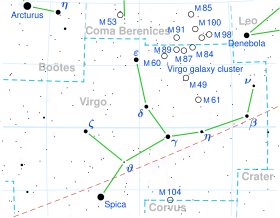| Observation data Epoch J2000.0 Equinox J2000.0 | |
|---|---|
| Constellation | Virgo |
| Right ascension | 11h 45m 17.04027s[1] |
| Declination | +08° 15′ 29.2150″[1] |
| Apparent magnitude (V) | 4.83[2] |
| Characteristics | |
| Spectral type | A4 V[3] |
| U−B color index | +0.10[2] |
| B−V color index | +0.17[2] |
| Astrometry | |
| Radial velocity (Rv) | −0.5[4] km/s |
| Proper motion (μ) | RA: +60.08[1] mas/yr Dec.: −24.50[1] mas/yr |
| Parallax (π) | 26.73 ± 0.25 mas[1] |
| Distance | 122 ± 1 ly (37.4 ± 0.3 pc) |
| Absolute magnitude (MV) | +1.98[5] |
| Details | |
| Mass | 1.93[6] M☉ |
| Radius | 1.5[7] R☉ |
| Luminosity | 12.6[8] L☉ |
| Surface gravity (log g) | 4.31[6] cgs |
| Temperature | 8,172[8] K |
| Rotational velocity (v sin i) | 130[3] km/s |
| Age | 480[9] Myr |
| Other designations | |
| Database references | |
| SIMBAD | data |
Xi Virginis (ξ Vir, ξ Virginis) is a solitary[11] star in the zodiac constellation of Virgo. It is bright enough to be seen with the naked eye, having an apparent visual magnitude of 4.83.[2] The distance to this star is about 122 light years, as determined from parallax readings.[1]
Xi Virginis is an A-type main sequence star with a stellar classification of A4 V.[3] It has an estimated age of 480[9] million years and is spinning rapidly with a projected rotational velocity of 130 km/s.[3] It has about 150%[7] the Sun's radius and shines with 12.6[8] times the luminosity of the Sun.
References[edit]
- ^ a b c d e f van Leeuwen, F. (2007), "Validation of the new Hipparcos reduction", Astronomy and Astrophysics, 474 (2): 653–664, arXiv:0708.1752, Bibcode:2007A&A...474..653V, doi:10.1051/0004-6361:20078357, S2CID 18759600.
- ^ a b c d Mermilliod, J.-C. (1986), "Compilation of Eggen's UBV data, transformed to UBV (unpublished)", Catalogue of Eggen's UBV Data. SIMBAD, Bibcode:1986EgUBV........0M.
- ^ a b c d Abt, Helmut A.; Morrell, Nidia I. (July 1995), "The Relation between Rotational Velocities and Spectral Peculiarities among A-Type Stars", Astrophysical Journal Supplement, 99: 135, Bibcode:1995ApJS...99..135A, doi:10.1086/192182.
- ^ Wilson, R. E. (1953), "General Catalogue of Stellar Radial Velocities", Carnegie Institute Washington D.C. Publication, Bibcode:1953GCRV..C......0W.
- ^ Anderson, E.; Francis, Ch. (2012), "XHIP: An extended hipparcos compilation", Astronomy Letters, 38 (5): 331, arXiv:1108.4971, Bibcode:2012AstL...38..331A, doi:10.1134/S1063773712050015, S2CID 119257644.
- ^ a b David, Trevor J.; Hillenbrand, Lynne A. (2015), "The Ages of Early-Type Stars: Strömgren Photometric Methods Calibrated, Validated, Tested, and Applied to Hosts and Prospective Hosts of Directly Imaged Exoplanets", The Astrophysical Journal, 804 (2): 146, arXiv:1501.03154, Bibcode:2015ApJ...804..146D, doi:10.1088/0004-637X/804/2/146, S2CID 33401607.
- ^ a b Pasinetti Fracassini, L. E.; et al. (2001), "Catalogue of Apparent Diameters and Absolute Radii of Stars (CADARS) - Third edition - Comments and statistics", Astronomy & Astrophysics, 367 (2): 521–24, arXiv:astro-ph/0012289, Bibcode:2001A&A...367..521P, doi:10.1051/0004-6361:20000451, S2CID 425754.
- ^ a b c McDonald, I.; et al. (2012), "Fundamental Parameters and Infrared Excesses of Hipparcos Stars", Monthly Notices of the Royal Astronomical Society, 427 (1): 343–57, arXiv:1208.2037, Bibcode:2012MNRAS.427..343M, doi:10.1111/j.1365-2966.2012.21873.x, S2CID 118665352.
- ^ a b Vican, Laura (June 2012), "Age Determination for 346 Nearby Stars in the Herschel DEBRIS Survey", The Astronomical Journal, 143 (6): 135, arXiv:1203.1966, Bibcode:2012AJ....143..135V, doi:10.1088/0004-6256/143/6/135, S2CID 118539505.
- ^ "ksi Vir -- Star", SIMBAD Astronomical Database, Centre de Données astronomiques de Strasbourg, retrieved 2016-09-08.
- ^ Eggleton, P. P.; Tokovinin, A. A. (September 2008), "A catalogue of multiplicity among bright stellar systems", Monthly Notices of the Royal Astronomical Society, 389 (2): 869–879, arXiv:0806.2878, Bibcode:2008MNRAS.389..869E, doi:10.1111/j.1365-2966.2008.13596.x, S2CID 14878976.

Well, that’s interesting to know that Psilotum nudum are known as whisk ferns. Psilotum nudum is the commoner species of the two. While the P. flaccidum is a rare species and is found in the tropical islands. Both the species are usually epiphytic in habit and grow upon tree ferns. These species may also be terrestrial and grow in humus or in the crevices of the rocks.
View the detailed Guide of Psilotum nudum: Detailed Study Of Psilotum Nudum (Whisk Fern), Classification, Anatomy, Reproduction